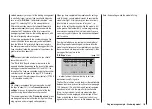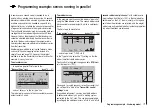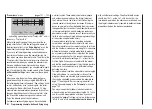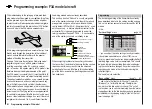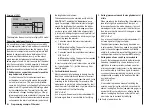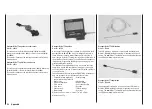
182
Programming example: F3A model
Programming example: F3A model aircraft
F3A models belong to the category of powered fixed-
wing model aircraft designed for competition flying. They
may be powered by an internal combustion engine or
an electric motor. Electric-powered models are eligible
and totally competitive in the international F3A “pattern”
class, and also in the F5A electric aerobatic class.
In this programming example we assume that you have
already read through the description of the individual
menus, and are therefore familiar with the general
method of handling the transmitter.
On page 164, where the section on fixed-wing model
programming starts, you will find general notes on
installing and setting up the RC system in a model,
and - of course - this applies equally to F3A models, and
therefore does not need to be repeated at this point.
If an F3A model is accurately built, it usually exhibits fly-
ing characteristics which are almost completely neutral.
The perfect aerobatic model has a very smooth but pre-
cise control response, and any movement around any
one of its flight axes should not affect the other axes.
F3A models are flown using aileron, elevator and rudder
controls. The use of separate servos for each aileron is
almost universal. The flying controls are supplemented
by control of motor power (throttle function) and in many
cases a retractable undercarriage. As a result the servo
assignment for channels 1 to 5 is no different from the
fixed-wing models we have already described.
The auxiliary function “Retracts” is usually assigned to
one of the auxiliary channels 6 to 8. Ideally the retracts
are operated using one of the two switches without a
centre detent (SW 3 or SW 8). An optional “extra” - used
only if necessary - is mixture adjustment control for the
carburettor. This is generally operated by one of the
rotary proportional controls CTRL 6 … 8, connected to
one of the auxiliary channels not already in use.
Throttle or speed
controller (electric motor)
Mixture adjustment
Retracts
Rudder
Aileron or left aileron
Elevator
Right aileron
Auxiliary function
Receiver power supply
When assigning functions to the auxiliary channels at
the transmitter, it is advisable to ensure that the controls
required are within easy reach, since the advanced
aerobatic pilot has very little time to think about letting
go of the sticks - especially when flying under competi-
tion conditions.
Programming
The basic programming of the transmitter has already
been described in detail in the section starting on page
166, so this section concentrates on tips specific to F3A
models.
In the …
“Servo settings”
menu
S1
S2
S3
rev cent
+
trav
0%
0%
0%
100% 100%
100% 100%
100% 100%
0%
0%
100% 100%
100% 100%
S4
S5
… you can adjust the servo settings to suit your model.
It has proved advisable to use at least 100% servo
travel, as precision of control can be perceptibly better if
relatively large servo travels are employed. This should
be borne in mind when building the model and design-
ing the control surface linkages. Any minor corrections
required can be made in the third column during the
initial test flights.
The next step is to select the …
“Base setting”
menu
… and activate the idle trim for Channel 1 (normally
“Idle back”; i. e. full-throttle forward). The digital trim
now works at the idle end of stick travel. The “cut-off
trim” enables you to switch immediately from the “motor
stopped” position to the idle position you have previously
established just by applying a single “click” on the trim
lever (see page 58).
Summary of Contents for mx-12 Hott
Page 1: ...Programming Manual 33116 mx 16 HoTT 3 en mx 16...
Page 35: ...35 For your notes...
Page 49: ...49 For your notes...
Page 55: ...55 For your notes...
Page 59: ...59 For your notes...
Page 63: ...63 For your notes...
Page 69: ...69 For your notes...
Page 91: ...91 For your notes...
Page 101: ...101 For your notes...
Page 123: ...123 For your notes...
Page 181: ...181 For your notes...
Page 193: ...193 For your notes...


